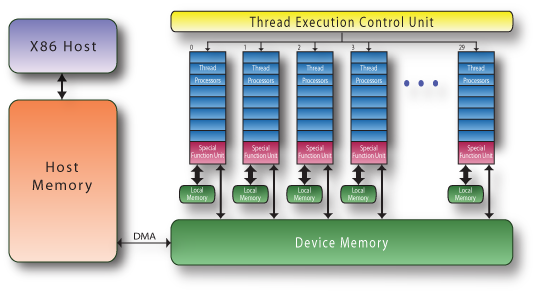This is what a computer that contains a graphics card computer look like:

There are actually 2 computer systems !!!
There is a traditional computer system consisting of the CPU + RAM:

You can see this computer system on the left side
There is a GPU computer system consisting of the GPU + "device memory":

You can see this computer system in the center (it is sticking out of the mother board)
|
|
Physical appearance of a GPU:

The GPU and device memory are inside the casing
Logical structure of a GPU:

Left: host ("ordinary" CPU) computer --- Right: the GPU computer
Note: a DMA processor is used to the transfer data between host memory and device memory
Architectural differences between the host (CPU) computer and the GPU computer:

(1) The CPU fetches 1 instruction (from RAM) and executes the instruction on 1 (pair) of input data
Architectural differences between the host (CPU) computer and the GPU computer:

(2) The GPU fetches 1 instruction (from Device Memory) and executes the instruction on many (pair) of input data
Data transfer between the host (CPU) computer and the GPU computer:

(3) The CPU controls the data transfer operations between RAM and device memory
How users interact with a GPU capable computer:

The user interacts with keyboard and terminal attached to the host computer
How users interact with a GPU capable computer:

The user controls the GPU computer through an Application Programming Interface (API) (e.g.: CUDA library functions)